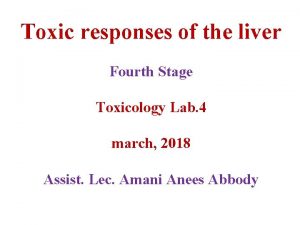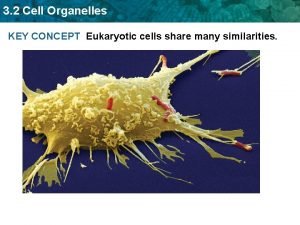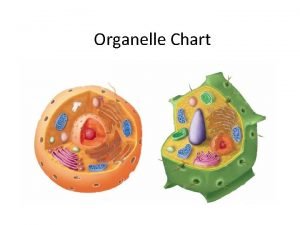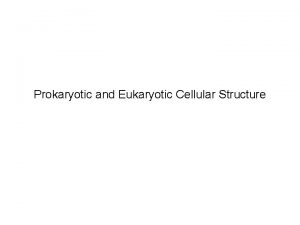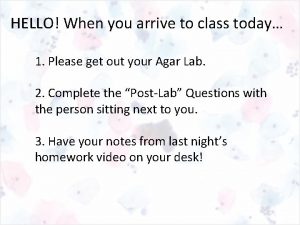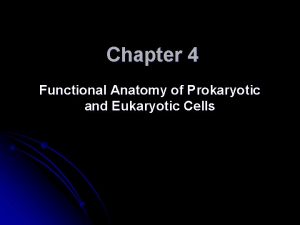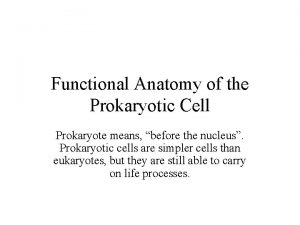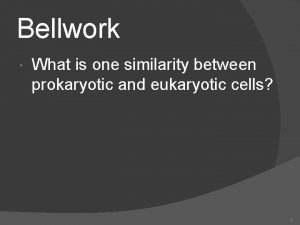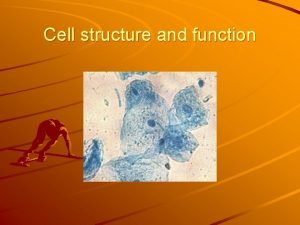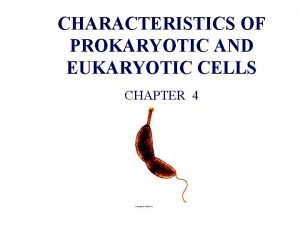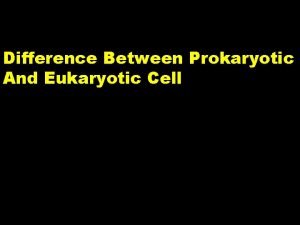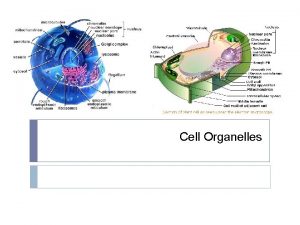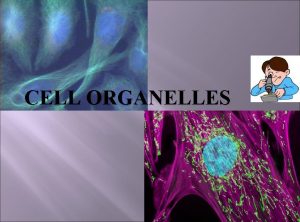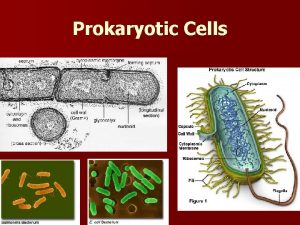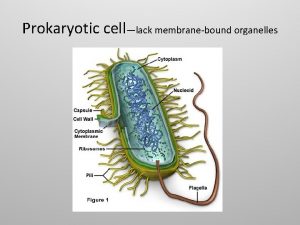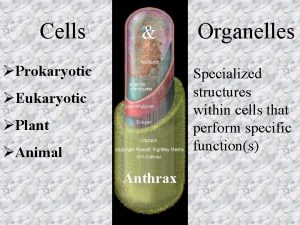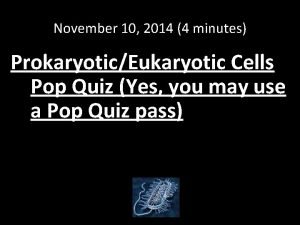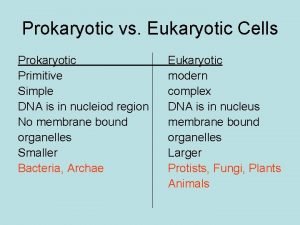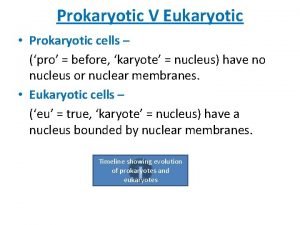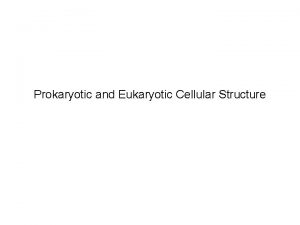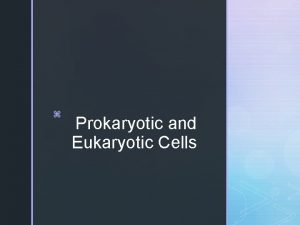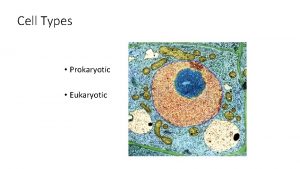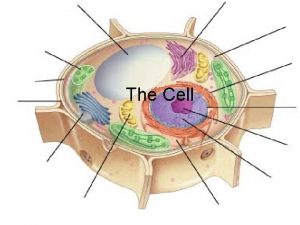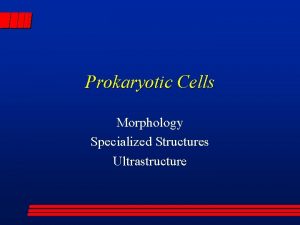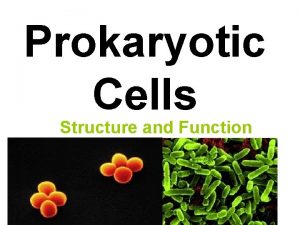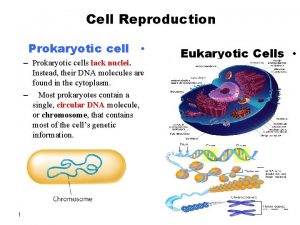CELLS THEIR ORGANELLES ProkaryoticEukaryotic n Prokaryotic cells n






















- Slides: 22

CELLS & THEIR ORGANELLES

Prokaryotic/Eukaryotic n Prokaryotic cells n no nucleus n n n Eukaryotic Cells n nucleoid region no membrane bound organelles small cell walls Examples n n bacteria blue green algae n n n membrane bound nucleus membrane bound organelles larger Examples n n n plants animal fungi

Bacterial Cell

Eukaryotic Cell

Membrane n n separates cell from the environment controls what enters and leaves n n semi permeable phospholipid bilayer with embedded proteins

Two Parts: • nucleus • cytoplasm

Nucleus n n control center of the cell nuclear envelope n n nucleolus n n n double membrane has pores made of RNA & Protein place where ribosomes are made chromosomes n n made of DNA & Proteins carry instructions

Cytoplasm n cell workplace n n chemical reactions take place fluid

Cytoplasmic Organelles n An internal membrane-bound sac or compartment carrying out a specific function.

Mitochondrion n power house n n site of cellular respiration produce ATP from glucose double membrane have their own DNA

Endoplasmic Reticulum n n transport Endoplasmic Reticulum can be either smooth or rough n rough has ribosomes n n smooth has NO ribosomes n n modifies proteins modifies fats begins at the nucleus and curves through the cytoplasm

Ribosomes n n n make proteins two parts : 1 large and 1 small made of RNA & protein n n three types of RNA t. RNA : transfers amino acids r. RNA : makes ribosomes m. RNA : carries the DNA message from the nucleus into the cytoplasm

Golgi Apparatus n n packages for export stack of membranous sacs

Vacuoles n storage n n nutrients waste enzymes water single membrane

Lysosomes n n n digest foreign particles and waste single membrane sac contain enzymes

Cytoskeleton n n gives shape and ability to move made of microtubules and microfilaments

Centrosome n n n aid in cell division made of microtubules two centrioles making T

PLANT CELLS

Cell Wall n n n support made of cellulose permeable

Chloroplast n make food n n double walled stroma n n contain chlorophyll converts light energy to chemical energy fluid grana n membranous stacks

Plant/Animal cells n n n cell wall large central vacuole chloroplasts square or rectangle NO centrioles n n n NO cell wall NO large central vacuole NO chloroplasts Round centrioles

Cell Quiz – Identify each organelle 15. Give three ways you can tell that this is a plant cell. 16. How can you tell this is a eukaryotic cell?
 Cell substance
Cell substance Prokaryotic vs eukaryotic cells venn diagram
Prokaryotic vs eukaryotic cells venn diagram What animals have prokaryotic cells
What animals have prokaryotic cells Prokaryotic cell wall
Prokaryotic cell wall What organisms are made of eukaryotic cells
What organisms are made of eukaryotic cells Liver cells organelles
Liver cells organelles Organelles in eukaryotic cells worksheet
Organelles in eukaryotic cells worksheet Animal cell plant cell venn diagram
Animal cell plant cell venn diagram Organelles facts
Organelles facts Plasma membrane prokaryotic
Plasma membrane prokaryotic What time did you arrive in class today
What time did you arrive in class today Prokaryotic cells
Prokaryotic cells What are three parts of the cell theory
What are three parts of the cell theory Anatomy of prokaryotes and eukaryotes
Anatomy of prokaryotes and eukaryotes Lable
Lable Characteristics
Characteristics How water moves
How water moves Similarity between prokaryotic and eukaryotic cells
Similarity between prokaryotic and eukaryotic cells Diff between prokaryotes and eukaryotes
Diff between prokaryotes and eukaryotes Prokaryotic cells lack
Prokaryotic cells lack Prokaryotic and eukaryotic cells chart
Prokaryotic and eukaryotic cells chart Characteristics of prokaryotic cells
Characteristics of prokaryotic cells Difference between prokaryotic and eukaryotic cells
Difference between prokaryotic and eukaryotic cells





